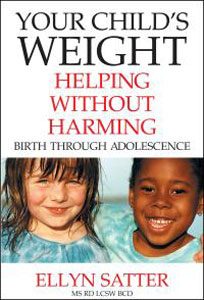

Family Meals Focus
The Ellyn Satter Institute Newsletter
Should you put your child on skim milk?
by Ellyn Satter, Registered Dietitian and Family Therapist
Children need fat in their milk, and that fat doesn’t make them gain too much weight. They are excellent at intuitively consuming the amount of calories they need to grow well. You can’t fool that ability by giving them lower fat, lower calorie milk. Unless their diet overall is being severely restricted, they simply get fat and other calories from somewhere else and consume the same amount – or maybe a little more. There is considerable evidence saying that low fat milk is not slimming, and, in fact, has the opposite effect. That evidence contradicts long-held convictions, and it appears to be ignored in making dietary recommendations for children.
Doctors and nutrition policy-makers recommend skim and low-fat milk
A Facebook message from a mom: I just took my 2 year old twins to the doctor for their check-up. He asked what percent milk I’m giving, I told him whole milk. He said after the age of 2, he recommends no higher than 2%. I have 4 boys, all on different ends of weight (one quite heavy, one quite slim, two that are in the middle) and I don’t want to buy different milks! The doc said for my heavy son that I should be using skim milk. This goes against what I thought I’ve read in your books, which are that the fat content being changed will lower calories, but then they will make up for the calories lost in other ways by eating more food.
You understand me correctly. Children are good regulators, and they balance out their own calories. Almost everyone is both data-resistant and behind the evidence on this topic. In his defense, your pediatrician is following the advice of the American Academy of Pediatrics (AAP),1 which is also behind the times in insisting that drinking low-fat milk and eating low-fat dairy products will decrease calorie and saturated fat intake, thereby decreasing obesity and heart disease. The Dietary Guidelines, which likely form the basis for the AAP recommendation, say the same thing.
The evidence: drinking low-fat milk doesn’t keep children slim
Almost everyone is both data-resistant and behind the evidence in insisting that drinking low-fat milk and eating low-fat dairy products will decrease calorie and saturated fat intake.
- A Virginia study that followed children from age 2 to 4 years found that over 80% of children drank whole milk and that those drinking 1% or skim milk were more likely to be overweight.2 So which came first, the overweight concern or the low-fat milk? We don’t know, but the point is that avoiding whole milk doesn’t slim children down.
- In a Cincinnati study of 12, 18, and 24 month-olds, children who drank whole milk consumed fewer calories, had only slightly more saturated fat, and grew the same as those who drank 2% milk.3
- Researchers in Boston found that intake of whole milk at age 2, but not reduced-fat milk, was associated with a slightly lower body mass index (BMI) z-score at age 3 years. Outcomes were adjusted for the usual risk factors: parental BMI and education, TV, nondairy beverages, and the like. At age 2 years, mean milk intake was 21 ounces per day.4
- A New Zealand study restricted all dairy foods of 4-13 year-olds to low fat. After 24 weeks, children ate no fewer calories, weighed no less, and had only a modest decrease in saturated fat intake.5
What about saturated fat?
Of course, the hold-out criticism of whole milk and full-fat dairy products is saturated fat, which has been accused of causing heart disease and therefore being a dietary no-no since the early 1970s.
- As I explain in Secrets of Feeding a Healthy Family,6 the evidence for branding dairy fat (and other animal fats) “bad food” that causes disease was never that strong to begin with.
- Newer evidence is finding the same,7 and creating much consternation among the nutrition policy-makers and those who make fat avoidance a cause célèbre.8
- A recent pooling and analysis of 76 previous studies found that a saturated fatty acid found in milk, margaric acid, is associated with less heart disease, not more.7 In other words, dairy fat could be protective against heart disease.
Why do I recommend whole milk?
This is what I say in Child of Mine.9 “Fat is an important source of energy [and essential fatty acids for brain and nervous system development]. Younger children [infants, toddlers and preschoolers] especially depend on milk to provide them with fat. After age 2, whole milk is still okay. So is 2 percent, 1 percent, or skim milk, if your child likes it and drinks it well and if you include other good sources of fat in your child’s diet. That concentrated fat source is critical. At every meal and snack, offer butter, cheese, salad dressing, avocado, bacon, gravy, cream, or some other fat. Many children don’t like low-fat milk as well as they like whole milk and consequently don’t drink as much of it. Since most parents drink low-fat milk, the main reason for switching the toddler to low-fat milk is to make it possible for everyone in the family to drink the same milk.”
It is easy to get your child’s fat intake too low
In this old but still valuable and realistic study,10 researchers found that using even one fat-reduction strategy with 2- and 3-year-olds can interfere with their getting enough fat, vitamins and minerals. For older children, use of more than one fat-reduction strategy can force their dietary fat percentages down to below 20%, way lower than the recommended 35%! Such a diet is not good-tasting, isn’t sustaining, and can interfere with children’s getting enough vitamins and minerals. Do not use low-fat milk if you . . .
- Use mostly lean meats or use low-fat food preparation techniques
- Limit the butter or salad dressing your child uses at meals and snacks
Think food seeking, not food avoidance
What should you do about whole milk and full-fat dairy products? Take the eating competence perspective, and think in terms of food seeking, not food avoidance.
- Use whole milk for children under age 2 years.
- After that, only switch to lower fat milk if everyone likes it, drinks it well, and has another reliable dietary fat source.
- Plan family-friendly meals with foods you enjoy from all the food groups (meat or other protein; a couple of starchy foods, such as rice, potatoes, bread or tortillas; fruit or vegetable or both; and milk).
- Include high-fat foods (butter, salad dressing, gravy, avocado, full-fat hummus), and let children (and other people) eat as much fatty food as they want. To get filled up, people with high calorie needs eat more, those with low calorie needs eat less.
References
- Gidding SS, Dennison BA, Birch LL, et al. Dietary recommendations for children and adolescents: a guide for practitioners. Pediatrics. 2006;117(2):544-559.
- Scharf RJ, Demmer RT, Deboer MD. Longitudinal evaluation of milk type consumed and weight status in preschoolers. Arch Dis Child. 2013;335-340.
- Wosje KS, Specker BL, Giddens J. No differences in growth or body composition from age 12 to 24 months between toddlers consuming 2% milk and toddlers consuming whole milk. Journal of the American Dietetic Association. 2001;101:53-56.
- Huh SY, Rifas-Shiman SL, Rich-Edwards JW, Taveras EM, Gillman MW. Prospective association between milk intake and adiposity in preschool-aged children. J Am Diet Assoc. 2010;110(4):563-570.
- Hendrie GA, Golley RK. Changing from regular-fat to low-fat dairy foods reduces saturated fat intake but not energy intake in 4-13-y-old children. The American journal of clinical nutrition. 2011;93(5):1117-1127.
- Satter EM. Appendix L. Diet and Degenerative Disease: It’s Not as Bad as You Think. Madison, WI: Kelcy Press; 2008.
- Chowdhury R, Warnakula S, Kunutsor S, et al. Association of dietary, circulating, and supplement fatty acids with coronary risk: a systematic review and meta-analysis. Ann Intern Med. 2014;160(6):398-406.
- Willett WC, Stampfer MJ, Sacks FM. Association of dietary, circulating, and supplement fatty acids with coronary risk. Ann Intern Med. 2014;161(6):453.
- Satter EM. Feeding Your Toddler: 12 to 36 months. In: Satter EM, ed. Child of Mine; Feeding with Love and Good Sense. Bolder, CO: Bull Publishing; 2000:349.
- Sigman-Grant M, Zimmerman S, Kris-Etherton PM. Dietary approaches for reducing fat intake of preschool-aged children. Pediatrics. 1993;91:955-960.
Explore
Understand and Apply ecSatter
For help with raising your big child or your small child to feel good about himself and have the body that is right for him, read Ellyn Satter's Your Child’s Weight: Helping Without Harming
Related issues of Family Meals Focus
- Child overweight: are current guidelines helpful? do they do harm?
- Children who are obsessed with food
- Court-ordered placement for child obesity: what can you do to help?
- Dieting and mental health
- Do children lose the ability to self-regulate?
- Food restriction in disguise
- Helping without harming with child overweight
- Managing “junk” food AKA sweet, chips, sodas
- Moves and counter-moves with feeding your child
- School nutrition horror stories
- Schools are not weight-loss camps
- Should you control portion sizes?
- Sticky topic of Halloween candy
- Vegetable agenda: Getting children to eat “nutritious” food

